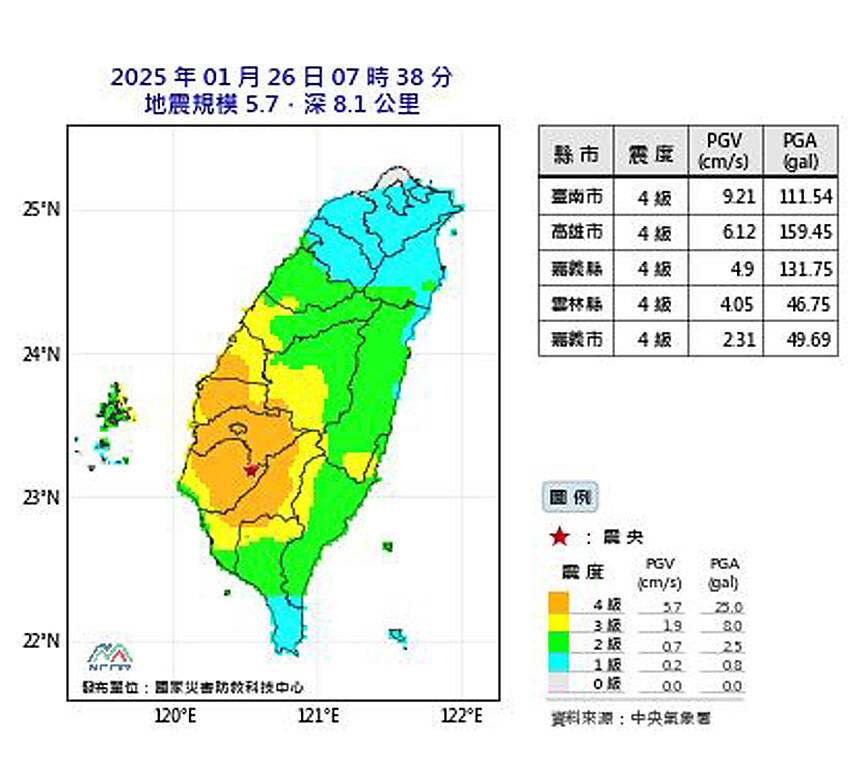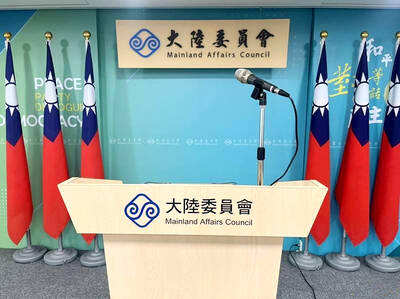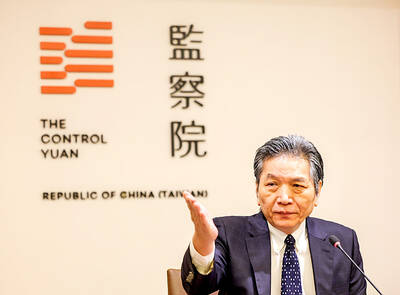Two magnitude 5.7 earthquakes that struck on Saturday night and yesterday morning were aftershocks triggered by a magnitude 6.4 quake on Tuesday last week, a seismologist said, adding that the epicenters of the aftershocks are moving westward.
Saturday and yesterday’s earthquakes occurred as people were preparing for the Lunar New Year holiday this week.
As of 10am yesterday, the Central Weather Administration (CWA) recorded 110 aftershocks from last week’s main earthquake, including six magnitude 5 to 6 quakes and 32 magnitude 4 to 5 tremors. Seventy-one of the earthquakes were smaller than magnitude 4.

Photo courtesy of the National Science and Technology Center for Disaster Reduction
Thirty-one of the aftershocks were felt nationwide, while 79 were regional.
The operations of Taiwan Railway Corp (台鐵) and the high-speed rail were slightly affected due to the quakes.
The hypocenter of the magnitude 5.7 earthquake on 7:49pm on Saturday was in Tainan’s Dongshan District (東山) at a depth of 7.7km, while the second one, which struck at 7:38am yesterday, was in Tainan’s Nansi District (楠西) at a depth of 8.1km.
The CWA categorized both as “very shallow earthquakes.”
Most of the aftershocks were recorded in Nansi, CWA data showed.
That the epicenter of Saturday’s quake was in Dongshan showed that aftershocks have begun to move west, National Chung Cheng University earth and environmental science professor Wen Yi-ying (?怡瑛) said.
“The quake was near Zengwen Reservoir (曾文水庫), and its epicenter was surrounded by faults in the south, north and west. Subsequent aftershocks in that area could damage the reservoir,” Wen said, adding that residents near the reservoir should be cautious.
Former Seismological Center director Kuo Kai-wen (郭鎧紋) said the magnitude 5.7 earthquake occurred because of movement on the Lunhou Fault (崙後斷層), a 48km-long fault that stretches from east of Chiayi County’s Chukou (觸口) to Tainan’s Zuojhen District (左鎮).
Of the 15 earthquakes recorded on Saturday, nine hit from Dongshan and four from Nansi, Kuo said.
The Nansi quakes were aftershocks of the earthquake that struck on Tuesday last week, while those from Dongshan were more related to the Lunhou Fault, he said
“It is not an active fault, and records show that it did not have a significant change in seismic activities over the past few years. However, it has a high strain rate,” he said. “The quake shows that the fault is in a state of aseismic slip, which is detectable without notable earthquakes. It also implies that crustal strain accumulates rapidly in the fault area, which has a very high potential for large earthquakes and should be closely monitored and studied.”
The CWA said that the reservoir was built on hard rock using the highest earthquake resistance coefficient and should withstand earthquakes, adding that the Water Resource Agency has also inspected the reservoir and found no problems.
Even though the largest intensity generated by the first 5.7 earthquake was Level 4, it lasted one to two seconds, the CWA said.
The farther away from the epicenter, the lower the intensity of the quake, it said.
The CWA urged people to evacuate the area immediately and protect themselves when they receive an earthquake alert on their cellphones from the Public Warning System.
That alert means the earthquake is serious, it said.
“The principle of evacuation is to lower the center of gravity, seek cover, and protect the head and neck,” it said. “When indoors, use items and hands to protect your head and neck, and avoid taking refuge under hanging objects or near movable furniture. When outdoors, stay away from dangerous areas such as buildings, trees and bridges, and avoid moving at high speeds to avoid accidents caused by the shaking.”

EUROPEAN TARGETS: The planned Munich center would support TSMC’s European customers to design high-performance, energy-efficient chips, an executive said Taiwan Semiconductor Manufacturing Co (TSMC, 台積電), the world’s largest contract chipmaker, yesterday said that it plans to launch a new research-and-development (R&D) center in Munich, Germany, next quarter to assist customers with chip design. TSMC Europe president Paul de Bot made the announcement during a technology symposium in Amsterdam on Tuesday, the chipmaker said. The new Munich center would be the firm’s first chip designing center in Europe, it said. The chipmaker has set up a major R&D center at its base of operations in Hsinchu and plans to create a new one in the US to provide services for major US customers,

BEIJING’S ‘PAWN’: ‘We, as Chinese, should never forget our roots, history, culture,’ Want Want Holdings general manager Tsai Wang-ting said at a summit in China The Mainland Affairs Council (MAC) yesterday condemned Want Want China Times Media Group (旺旺中時媒體集團) for making comments at the Cross-Strait Chinese Culture Summit that it said have damaged Taiwan’s sovereignty, adding that it would investigate if the group had colluded with China in the matter and contravened cross-strait regulations. The council issued a statement after Want Want Holdings (旺旺集團有限公司) general manager Tsai Wang-ting (蔡旺庭), the third son of the group’s founder, Tsai Eng-meng (蔡衍明), said at the summit last week that the group originated in “Chinese Taiwan,” and has developed and prospered in “the motherland.” “We, as Chinese, should never

‘A SURVIVAL QUESTION’: US officials have been urging the opposition KMT and TPP not to block defense spending, especially the special defense budget, an official said The US plans to ramp up weapons sales to Taiwan to a level exceeding US President Donald Trump’s first term as part of an effort to deter China as it intensifies military pressure on the nation, two US officials said on condition of anonymity. If US arms sales do accelerate, it could ease worries about the extent of Trump’s commitment to Taiwan. It would also add new friction to the tense US-China relationship. The officials said they expect US approvals for weapons sales to Taiwan over the next four years to surpass those in Trump’s first term, with one of them saying

‘ABUSE OF POWER’: Lee Chun-yi allegedly used a Control Yuan vehicle to transport his dog to a pet grooming salon and take his wife to restaurants, media reports said Control Yuan Secretary-General Lee Chun-yi (李俊俋) resigned on Sunday night, admitting that he had misused a government vehicle, as reported by the media. Control Yuan Vice President Lee Hung-chun (李鴻鈞) yesterday apologized to the public over the issue. The watchdog body would follow up on similar accusations made by the Chinese Nationalist Party (KMT) and would investigate the alleged misuse of government vehicles by three other Control Yuan members: Su Li-chiung (蘇麗瓊), Lin Yu-jung (林郁容) and Wang Jung-chang (王榮璋), Lee Hung-chun said. Lee Chun-yi in a statement apologized for using a Control Yuan vehicle to transport his dog to a